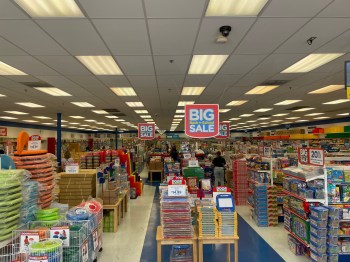More teachers pay to stock the classroom supply closet
You might consider office supplies provided by your employer a given — but not if you’re a teacher. A survey this year by the National School Supply and Equipment Association found that virtually all teachers — 99.5 percent — use their own money to buy basic classroom supplies. Last school year, teachers shelled out an average of $485 over the course of a year.
At Roosevelt High School in Des Moines, Iowa, English teacher Haley Moehlis spent the days leading up to the beginning of school scanning dozens of books to create a digital library. She bought most of those books, and the bookcases, too. The old ones the school provides don’t really fit in her room.
“I needed to be able to have furniture that I could work around, so that I could have access to the whiteboards,” Moehlis says.
The English department has a supply budget: $1500 for 12 teachers, who all teach several classes. It doesn’t go far, so Moehlis spends about $200 of her own money just getting her classroom ready each year. And that’s just the beginning.
“Over the course of the year it’s the little things that add up,” she says.
Like many teachers, Moehlis buys paper and pens to keep on hand for students who forget them — or can’t afford them.
Her colleague, guidance counselor Ryan Williamson, also stocks school supplies for students in need. He’s even bought students clothing and driven them to college visits, on his own dime.
“The hard part is figuring out which students need the help but are too proud to ask,” Williamson says.
Dennis Van Roekel, president of the National Education Association, says most educators are helping to fill gaps in education funding in similar ways.
“I think teachers have always spent out of their own pocket,” he says. “But I think it has really gone up as school supply budgets have decreased.”
But the same economic forces that put pressure on schools and families also affect teachers. The NSSEA survey found that while teacher spending is rising, it’s still less than before the recession.
“The last couple of years, when we’ve all taken pay cuts, it’s been harder and harder to reach into our pockets,” says Colleen Briner-Schmidt, president of a teachers union in Thousand Oaks, California.
But she says teachers still do what they can to make sure students are ready to learn, even if their own paychecks take a hit.
There’s a lot happening in the world. Through it all, Marketplace is here for you.
You rely on Marketplace to break down the world’s events and tell you how it affects you in a fact-based, approachable way. We rely on your financial support to keep making that possible.
Your donation today powers the independent journalism that you rely on. For just $5/month, you can help sustain Marketplace so we can keep reporting on the things that matter to you.


















